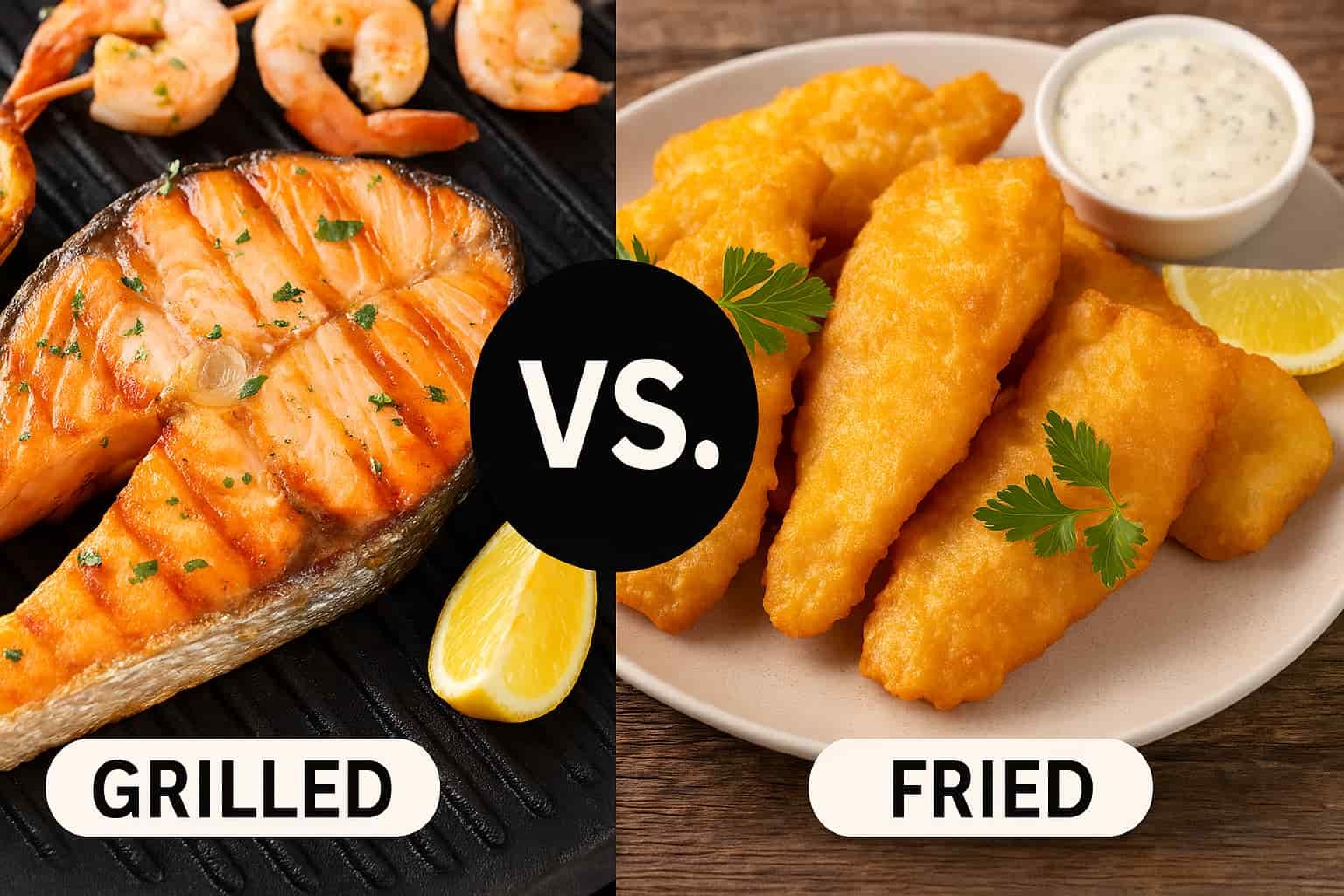Seafood lovers are often faced with a delicious dilemma: should you grill it or fry it? Both cooking methods have their unique advantages and bring out different flavors, textures, and aromas in your favorite fish or shellfish. Whether you’re planning a healthy weeknight dinner or a decadent weekend feast, choosing the right technique can elevate your seafood experience.
Grilling is often praised for being healthier and preserving the natural taste of seafood. On the other hand, frying is celebrated for creating that irresistible crispy bite and indulgent richness. But which method is better overall? That depends on your priorities—nutrition, taste, ease, and the type of seafood you’re working with.
In this article, we’ll dive deep into the pros and cons of grilling vs. frying seafood. We’ll explore how each method affects flavor, nutrition, texture, and which types of seafood are best suited to each technique.
Contents
- 1 Grilling Seafood: Healthier and Flavorful
- 2 Frying Seafood: Crispy and Indulgent
- 3 Nutrition Showdown: Grilled vs. Fried
- 4 Texture and Flavor Differences
- 5 When to Use Each Method: Seafood Pairing Guide
- 6 Practical Tips for Grilling Seafood Like a Pro
- 7 Frying Seafood Safely and Effectively
- 8 Choosing Based on the Occasion
- 9 Conclusion: Which One Wins?
Grilling Seafood: Healthier and Flavorful
Grilling is one of the most popular methods for preparing seafood, especially in health-conscious kitchens. This technique allows you to cook fish and shellfish using minimal oil while enhancing their natural flavors. Whether you’re working with a gas grill, charcoal, or even a stovetop grill pan, the results can be deeply satisfying.
From a nutritional perspective, grilling helps retain omega-3 fatty acids and lean protein while avoiding the heavy fats and calories that come with deep-frying. It also imparts a smoky, charred flavor that works particularly well with oily fish like salmon, mackerel, or tuna.
Grilling is ideal for firmer seafood that can hold its shape over high heat. Popular choices include shrimp skewers, scallops, squid, and thick-cut fillets. To avoid sticking, always oil the grill grates and use a spatula to turn delicate fish. You can also wrap seafood in foil with herbs and citrus for a moist, steamed effect with grilled aroma.
Another tip: avoid overcooking. Seafood cooks quickly on the grill and can dry out if left too long. Mastering the timing and temperature is key to achieving juicy, perfectly grilled results.
Frying Seafood: Crispy and Indulgent
If you’re craving something crispy, golden, and satisfying, frying seafood might be the answer. This method, whether deep-fried or pan-fried, locks in moisture while creating a crunchy exterior that makes every bite addictive.
Fried seafood is a staple in many cuisines, from British fish and chips to Southern-style fried catfish and tempura prawns. The texture is undeniably appealing—crispy on the outside, tender on the inside—and it pairs wonderfully with dipping sauces and sides like fries or coleslaw.
This method works especially well with lean, white fish like cod, haddock, and tilapia. It’s also perfect for shrimp, calamari rings, and soft-shell crab. A good batter or breadcrumb coating helps seal in flavor and prevents the seafood from becoming greasy.
For best results, fry at a consistent high temperature (around 350–375°F or 175–190°C). Too low, and your seafood absorbs excess oil; too high, and it burns before cooking through. A thermometer and small test pieces can help you control the outcome.
While frying is less healthy than grilling, using clean, high-quality oil and draining fried items properly can make it a little lighter. And sometimes, the flavor is just worth it.
Nutrition Showdown: Grilled vs. Fried
When it comes to health and nutrition, grilled seafood typically comes out ahead. Grilling uses little to no oil, which means lower calorie content and less saturated fat. It also helps preserve beneficial nutrients such as omega-3 fatty acids, which are essential for heart and brain health.
Fried seafood, on the other hand, tends to be higher in calories and fat. The breading or batter adds carbohydrates, and the oil used in frying can significantly increase the calorie count—especially if the seafood absorbs excess oil. Depending on the type of oil and cooking method used, fried seafood can also contain trans fats, which are harmful to cardiovascular health.
That said, moderation and smart choices can make fried seafood an occasional indulgence without ruining your diet. Using oils with high smoke points like avocado or grapeseed oil and frying at the proper temperature helps reduce oil absorption. Draining on paper towels and avoiding heavy batters can also make a difference.
If you’re managing your weight, cholesterol levels, or overall health, grilled seafood is generally the better choice. But for a treat or a cheat day, a crisp fried fillet still has its place at the table.
Texture and Flavor Differences
One of the biggest distinctions between grilled and fried seafood is the texture and flavor they produce. Grilling tends to enhance the natural qualities of the seafood. The exterior develops slight char marks while the interior stays moist and flaky. The smoky aroma from charcoal or wood adds a depth that’s hard to replicate with other cooking methods.
Fried seafood, in contrast, offers a completely different sensory experience. The crispy outer layer created by batter or breadcrumbs gives way to a soft, juicy interior. The contrast in texture is a big part of what makes fried seafood so appealing, especially when paired with creamy or tangy sauces.
Flavor-wise, grilled seafood allows the taste of the fish or shellfish to shine through, especially when seasoned lightly with herbs, garlic, citrus, or marinades. Fried seafood has a richer, more indulgent taste due to the oil and coating, which can sometimes overpower the natural flavor of the seafood—but also creates that comforting, crave-worthy bite.
Ultimately, your choice may depend on the experience you’re after: bold, natural, and smoky—or crispy, rich, and satisfying.
When to Use Each Method: Seafood Pairing Guide
The best cooking method often depends on the type of seafood you’re working with. Grilling is ideal for hearty, firm-textured seafood that can hold up to direct heat. Salmon, swordfish, tuna steaks, shrimp, scallops, and squid all perform beautifully on the grill. Their structure stays intact, and they develop a lovely sear without falling apart.
Frying works best with delicate or flaky seafood that might break down or dry out on the grill. White fish like cod, haddock, catfish, and tilapia are prime candidates. The frying process adds structure through batter or breadcrumbs, making them easy to handle and delicious to eat. Shellfish like shrimp and calamari also shine when fried, delivering a crisp bite and tender interior.
Here’s a simple breakdown to guide your decision:
| Seafood Type | Best Method | Why |
|---|---|---|
| Salmon, Tuna | Grilling | Firm texture, rich in natural oils |
| Cod, Haddock | Frying | Mild flavor, benefits from coating |
| Shrimp | Both | Quick to cook, versatile |
| Scallops | Grilling | Sweet flavor enhanced by sear |
| Calamari | Frying | Tender rings with crispy texture |
Still not sure about scallops? Read Sea Scallops vs. Bay Scallops: What’s the Real Difference? to help decide.
Choosing the right method brings out the best in each seafood type, whether you’re planning a light grilled platter or a comforting fried feast.
Practical Tips for Grilling Seafood Like a Pro
Grilling seafood might seem intimidating at first, but with the right preparation and tools, it can be simple and rewarding. The key is to prevent sticking, preserve moisture, and avoid overcooking.
1. Use high heat and clean grates. Preheat your grill to medium-high and ensure the grates are clean and well-oiled. This helps prevent delicate fish or shellfish from sticking and tearing.
2. Marinate or season lightly. Simple marinades with olive oil, lemon juice, herbs, or spices work wonders. Avoid sugary marinades, which can burn quickly on the grill.
3. Use skewers, grill baskets, or foil. For small seafood like shrimp or scallops, skewers help with handling. Grill baskets are great for delicate fillets or mixed seafood. Wrapping fish in foil with aromatics like garlic and dill helps retain moisture.
4. Don’t flip too soon. Let the seafood develop a crust before flipping. Most fish only need one turn and cook in just a few minutes per side.
With a little practice, you’ll master the art of grilled seafood and impress family and guests with smoky, delicious results.
Frying Seafood Safely and Effectively
Frying seafood can be messy, but when done right, it delivers unbeatable crunch and flavor. To make the process safer and more successful, follow these key tips:
1. Choose the right oil. Use oils with high smoke points, such as canola, peanut, avocado, or sunflower oil. These oils can handle the high heat of frying without breaking down and producing off flavors.
2. Maintain the right temperature. Keep the oil between 350°F and 375°F (175°C to 190°C). A kitchen thermometer is extremely helpful. Too hot, and the coating will burn; too cool, and your seafood will absorb too much oil.
3. Prepare your coating. Lightly dusting with flour or using a beer batter, cornmeal crust, or seasoned breadcrumbs adds texture. Let coated seafood rest for a few minutes before frying so the coating sticks better.
4. Avoid overcrowding. Fry in small batches to maintain the oil temperature. Overcrowding leads to soggy, uneven results.
5. Drain properly. Let fried seafood rest on a rack or paper towels to remove excess oil. Season while hot for best flavor.
These steps help ensure your fried seafood is crispy, not greasy, and flavorful all the way through.
Choosing Based on the Occasion
The ideal cooking method often depends on the context in which you’re serving seafood. For healthy weeknight dinners, grilled seafood is a no-brainer. It’s quick, low in calories, and pairs well with salads, steamed veggies, or rice. Plus, it’s easy to scale up for meal prep or family-style portions.
On the other hand, fried seafood shines in more casual or festive settings—think game day snacks, comfort food dinners, or seafood platters with dipping sauces. It’s a crowd-pleaser, especially for kids and picky eaters who may prefer the crunch and familiar taste.
You might also consider combining both in one meal: grilled shrimp skewers with a side of crispy calamari, for example. This adds variety and caters to different preferences without much extra effort.
Ultimately, the best method is the one that suits your goals, time, and taste for the moment.
Conclusion: Which One Wins?
So, is grilled or fried seafood the better cooking method? The answer isn’t so clear-cut—it depends on your priorities and preferences.
If health is your focus, grilled seafood is the clear winner. It retains essential nutrients, avoids excess calories, and enhances natural flavors with a smoky twist. It’s ideal for clean eating and brings out the best in fresh, high-quality seafood.
If you’re after indulgence and texture, fried seafood delivers that golden crunch and richness that’s hard to resist. When done right, it’s a satisfying treat that can be part of a balanced lifestyle when enjoyed occasionally.
Rather than choosing one method over the other, consider them tools for different culinary goals. Grill seafood for weekday wellness, and save frying for when you’re celebrating or craving comfort food.
No matter which method you choose, understanding the right technique and pairing it with the right type of seafood will elevate your cooking. Whether it’s a grilled salmon filet or crispy fish tacos, great seafood is about balance, flavor, and the joy of eating.



